I’m sure you’re all aware of what purebred dogs are and what mixed breed dogs are.
While purebred dogs come from the same dog breeds, and they all have the same breed standard, mixed breeds don’t. They come from two or more different dog breeds, and they don’t have a standard.
That’s why it’s absolutely reasonable to ask questions like, “How do you tell how big a mixed puppy will get?”
I understand your worry. There are hardly any ways to determine a puppy’s adult size if it comes from different dog breeds.
Of course, there’s the standard visual test, and common sense. I mean, can you really expect a giant from two small dog breeds? I didn’t think so!
If the parents are large dogs, then their puppies will naturally be large. If they’re small, the whole litter will be small, too.
But, what if the mixed breed puppy has parents of different sizes? Will the puppy be small or large? Or, maybe a middle-sized puppy?
If you don’t want to risk that your crossbreed puppy will become a giant you can’t handle, or a teacup pup that’s too fragile, I suggest you go with purebred dogs with determined size standards.
If the size isn’t an issue for you, and you only want to learn how big a mixed puppy will get, stay tuned.
I’ve got tips, tricks, methods, and some basic calculations for you that might come in handy when choosing your new best friend.
So, How Do You Tell How Big A Mixed Puppy Will Get?
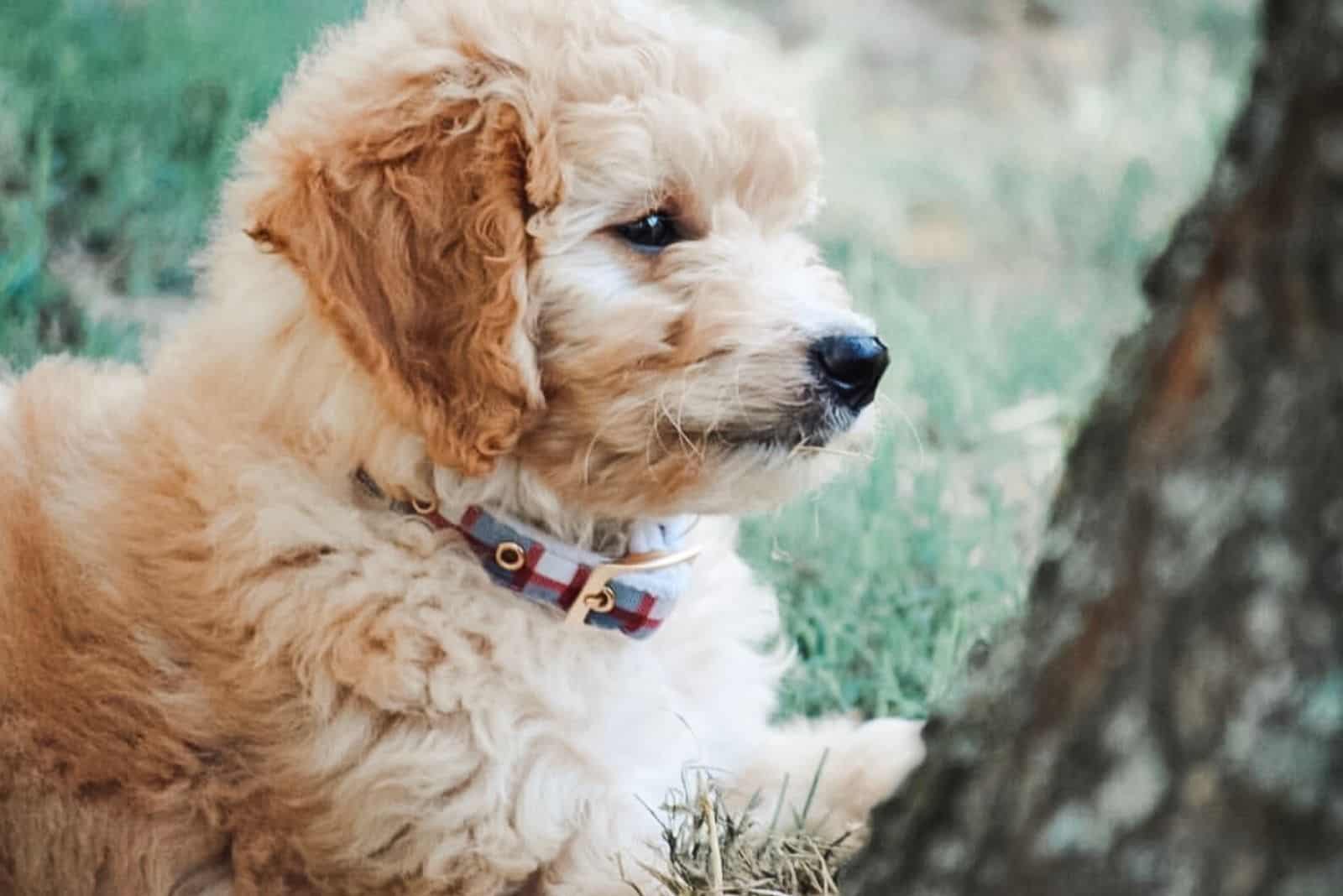
Before we crunch some numbers and do light calculations on how to tell how big a mixed puppy will get, let’s clear up something regarding dog sizes in general.
First, you need to learn that small, medium, and large aren’t really dog sizes. Dogs come in teacup and giant size varieties, too!
Generally speaking, size groups for adult dogs go like this:
SMALL DOGS (up to 20 pounds and less) such as Chihuahuas, French Bulldogs, Pomeranians, or Dachshunds.
MEDIUM-SIZED DOGS (not less than 20 lbs, and not over 60 lbs) such as Beagles, Border Collies, and Poodles.
LARGE DOGS (over 60 lbs, and up to 120 lbs) such as Golden Retrievers, Labrador Retrievers, Huskies, Pitbulls, and German Shepherds.
GIANT DOGS (over 120 pounds) like Great Danes or some Mastiffs.
Teacup dogs are often so tiny that they don’t weigh more than a few pounds. It’s considered unethical to breed them just to achieve the tiny size.
Small-breed dogs will achieve their adult height and weight faster, some time around their first birthday. They have a fast growth rate, unlike medium breeds or larger dogs.
No one can really tell precisely how big a mutt will be. But, we can determine a size range based on some predictions, looking at the puppy’s paws, or following the methods used by professionals.
Let’s check out those methods together!
How Can I Estimate My Dog’s Size? The Puppy Weight Calculator
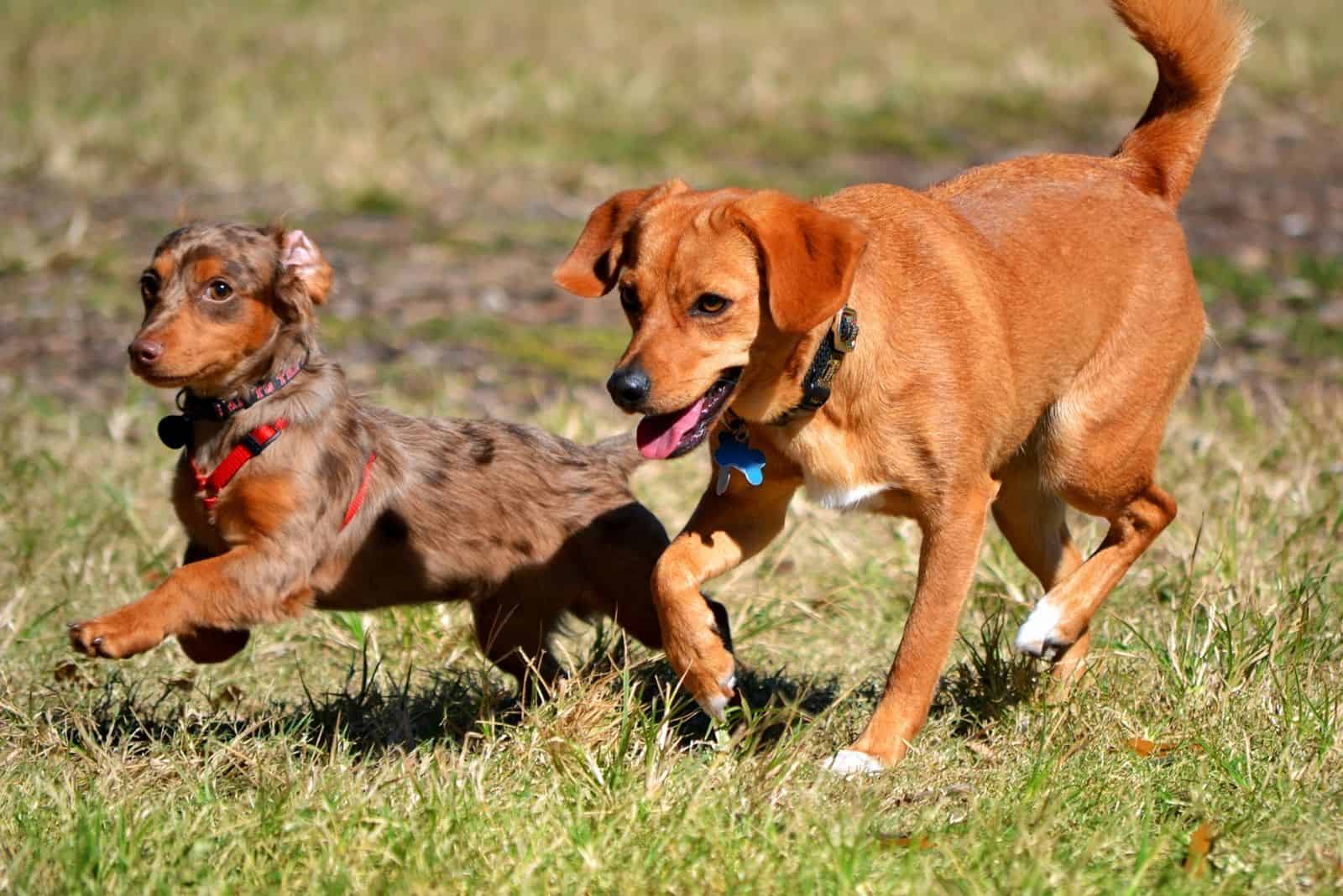
When deciding how big your puppy will be once he grows up, common sense plays a major role.
You see, if you have a small dog like a Chihuahua, and you breed it with a larger breed like a Golden Retriever, you can’t expect the puppies to be tinier than the Chi, or bigger than the Golden.
You’ll get a lot of help if you know the puppy’s parents. If the breeds are known, you can determine the puppy’s size by looking at the mother.
Female puppies should be as big as their mom. But, males are slightly bigger than their mom. So, that’s a really nice indicator of the size. We can do some calculations, but they’re nothing unless you see the example in person.
If you’re having trouble determining how big a puppy will be, you can always ask your vet for some help. Vets usually say that every puppy at four months of age is four times its dog weight and size. Also, if it’s a popular crossbreed, they will have height and weight charts for you.
Now, I know you’re hoping that there’s a magical formula or a calculator that will do the hard work for you. There is! In fact, there are three weight calculators, and we’ll check out each one of them.
Weight Calculator #1
The first weight calculator works on the presumption that dogs turn adults at their first birthday.
Since we have different breeds with different weights, you know this can’t be true for all of them.
This calculator generally works well for smaller-breed pups, and this is how you do it:
You calculate your dog’s growth first, then you multiply it by 52 (the number of weeks in a year). Yes, this method is based on the weeks instead of the months.
Your dog’s growth is your dog’s current weight divided by its age.
Here’s a little example to help you understand better:
Let’s say you own a Corgi Beagle mix that’s 11 pounds at the age of 14 weeks.
That’s 11/14 x 52 = 40 pounds
Your Corgi Beagle mix should weigh 40 pounds once he’s a grown up.
Weight Calculator #2
The second weight calculator works differently on different breed sizes. This means that it’s not the same for a Yorkshire Terrier and a GSD.
For small and toy breeds like the Yorkie, the adult size can be predicted if you multiply their weight at 6 weeks by 4. For example, that’s 17.5 oz x 4 = 4.36 pounds.
Large breeds can get their adult weight calculated by multiplying their weight at 14 weeks with 2.5. If you own a Labrador Retriever mix, that would be 21 lbs x 2.5 = 52.5 pounds.
Lastly, with giant breeds like the Rottweiler, multiply their current weight at 16 weeks with 2. If we say your Rottie is 40 pounds, that would be 40 lbs x 2 = 80 pounds.
Weight Calculator #3
By using the third weight calculator, you can determine your small dog’s future weight if you measure the puppy at the age of 6 weeks, double that weight, and then double that result. Let’s say your pup is (8 lbs x 2) x 2 = 32 pounds.
Medium-sized dogs should be weighed at 14 weeks, then double that result, and add only half of the starting weight. That would be 22 lbs x 2 + 11 = 55 pounds.
Big dog breeds should be measured at 6 months of age. Then, the puppy’s weight should be doubled. For example, 35 lbs x 2 = 70 pounds.
DISCLAIMER: What I want to stress is that not every dog is the same, especially not mixed-breed puppies. It would be best to measure your buddy’s weight at certain weeks, and follow the growth along with your veterinarian.
How Tall Will My Mixed-Breed Puppy Be?
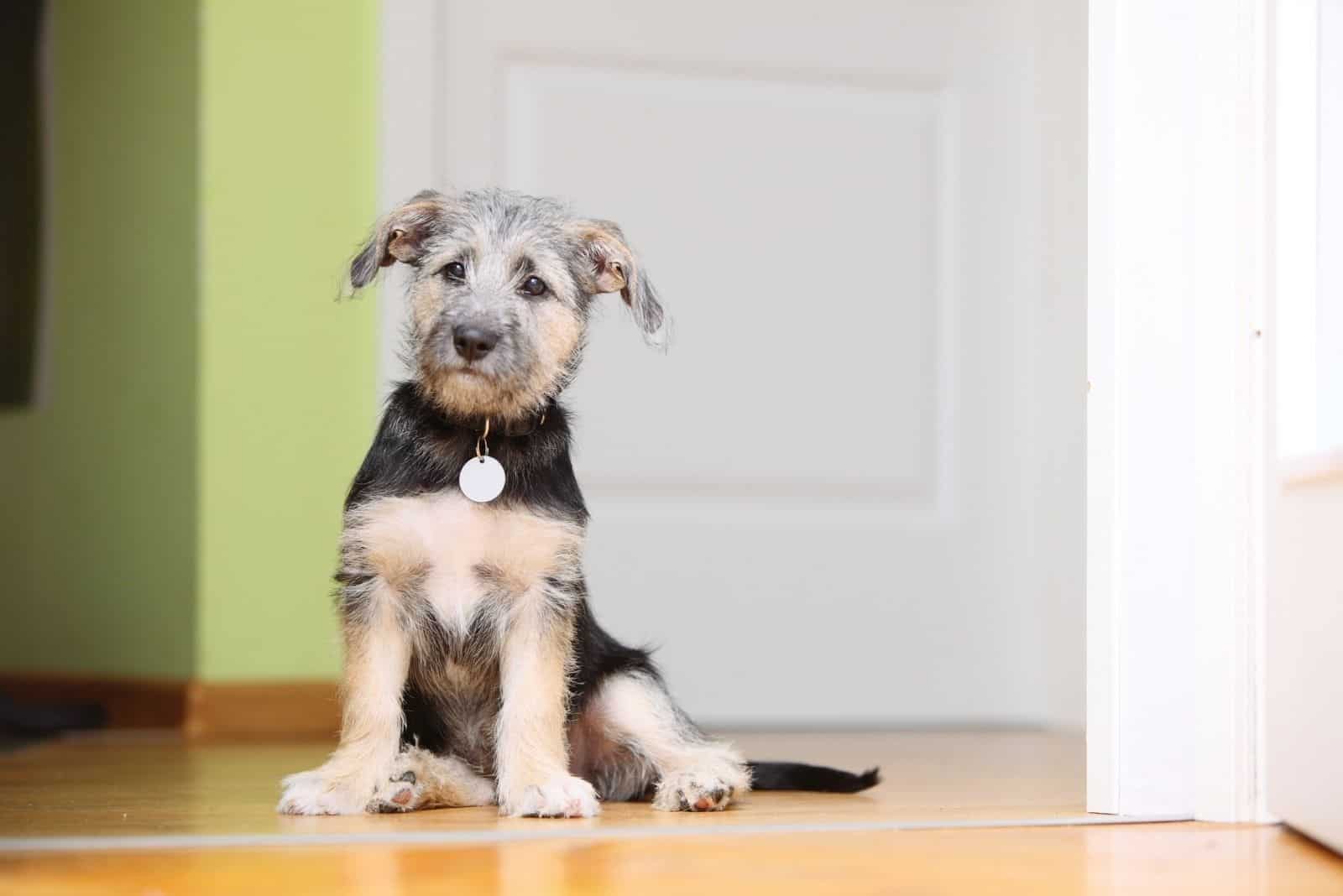
As with weight, the mixed-breed puppy’s height will depend on the parent breeds.
Puppies grow extensively in the first six months of their lives. Depending on the size, they will reach their adult height around their first or second birthday. A puppy’s growth plates will start to close at this age, and will continue until the puppy is an adult.
If you’re wondering whether there’s some kind of a formula to calculate your dog’s future height, there is!
You can easily calculate your puppy’s adult height if you measure it at six months, multiply that by 100, and then divide that by 75.
Let’s say your puppy is 6 inches at the withers. That’s:
(6” x 100) / 75 = 8 inches
Your puppy should be around 8 inches once he’s all grown up.
Of course, the final size depends on many factors such as the dog’s breed, its way of upbringing, nutrition, potential health issues, etc.
At What Age Can You Tell How Big A Puppy Will Be? Puppy Growth By Stages
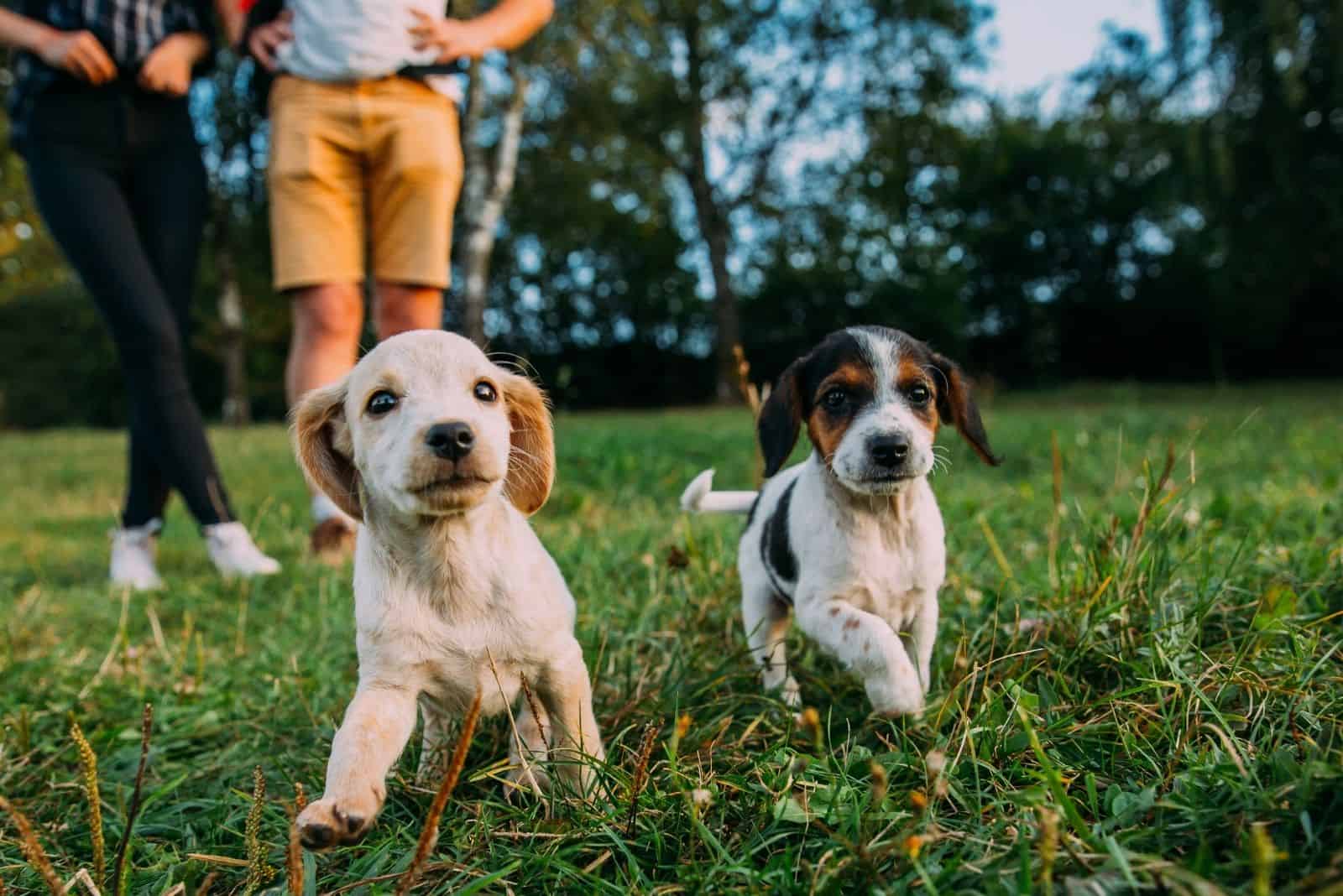
Of course, it’s impossible to tell how big a mixed puppy will get at the beginning of its life. Early months are not helpful in terms of determining the puppy’s future size. In fact, it will take some time before you can figure out how big a hybrid puppy will be.
This isn’t something you can tell at, i.e., six months of age or nine months of age. That’s still too soon to guess a puppy’s size.
Not all puppies have the same growth rate. Some will reach their full size earlier than others, and that’s because of lots of different factors like the parent breeds or the nutrition.
For most puppies, there’s a window when they reach their full size, and it’s usually from their fourteenth month up to their second birthday.
This is a fairly long period of time in which dogs grow in height, and add on extra weight and muscles. After this milestone, puppies should stop growing. They’re considered adult dogs once this happens.
To help you figure out how puppies grow, I’ve divided their months into several milestones. You should be able to learn what happens at birth, how fast puppies grow, and why each month is special in terms of growing.
From Birth To The First Two Weeks
This is definitely the least exciting phase in a puppy’s life because nothing really happens.
At this point, puppies can’t see or move. They can only smell and taste, but still rely pretty much on their mom’s help.
It’s time for cuddles with mom, soaking up energy, and getting big and strong in order to face the big world.
Weeks Three And Four
This is when things get interesting.
Your new puppy will start to move on its own, sniff, bark, walk, and show excitement when you’re around. They still pretty much rely on their mom, but things are about to change.
I know it will be difficult to socialize your puppy since it’s so playful at this stage, but keep on working together. The results will be visible soon.
Months One To Three
During this period, it’s crucial for the puppies to get socialized.
Of course, socialization isn’t something that can be fit into one day. It’s a continuous process during which your puppy learns how to act around new people, animals, and situations.
Months Three To Six
This puppy stage is the period I like the most and I’m sure you’ll agree, too.
Puppies are now bouncy balls of joy, playing all the time, exploring, showing affection, and simply being adorable. Don’t worry – they will get easier!
Their motor skills are now mastered, and they’re able to play with their littermates while learning to be dominant or submissive.
From Six Months On
This is the period when puppies run freely to their adulthood. Depending on the dog breed, your puppy will either become an adult at the age of 12 months, or he’ll keep on growing for the following year or so.
Can Paw Size And Bone Structure Tell How Big My Puppy Will Get?

Before we knew those calculating formulas from above, we used other ways to figure out a puppy’s future size.
A general rule of thumb says you can expect big-sized dogs from puppies with large paws. You can’t expect a puppy with tiny paws to grow into a giant.
But, why is that so? Why do people look at the dog’s paws in the first place? How can a paw say how big a puppy will be?
Believe it or not, the answer is quite logical!
What do dogs stand on? Their paws!
Can tiny paws carry over 120 pounds of a giant dog?
Exactly!
This method is pretty safe to use, but keep in mind that some puppies with large paws can only grow up to be medium-sized dogs on the bigger end.
Generally speaking, paws have different sizes, but they all fall under three categories: small, medium, and large.
Small paws are no bigger than 2 inches. Medium paws are from 2 to 3 inches big. And, large paws are over 3 inches.
What you can do is take a tape measure and simply measure your puppy’s paws. It may sound silly, but how else would you know it?
Another trick that people are using to determine a puppy’s future size is the amount of loose skin a puppy has. This means that unless it’s a breed specification, the puppy should fill out and grow into that loose skin.
Lastly, it’s only natural to assume that a puppy with a bigger bone structure will grow up to be a large dog. A runt of the litter has no chance in becoming a giant whatsoever.
How Long Does It Take For A Puppy To Grow Into Its Adult Size?
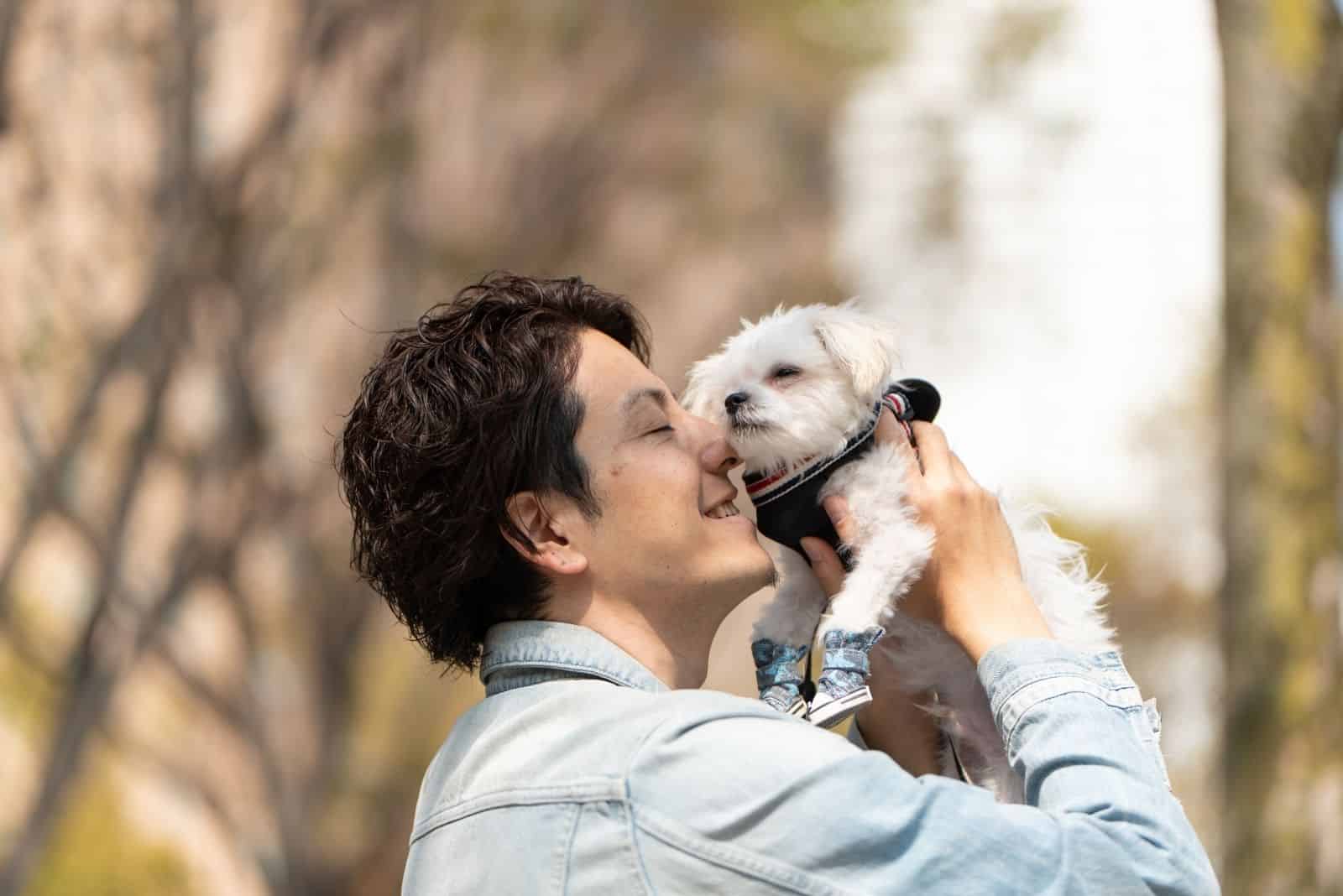
Growing up is a continuous process.
I know some of you would like to skip the puppyhood phase and move straight into the dog’s adulthood, but that’s not how things work. Puppyhood is a crucial part of every dog’s life since it’s the time when dogs learn everything they’re supposed to.
Ever tried teaching an older dog obedience? It’s hard, right? That’s because that dog already has a formed attitude and it’s almost impossible to break it.
Socialization, weaning, puppy training, potty lessons, etc. are all the things that need to be taught until the dog grows up.
So, when exactly does a dog become a grown up?
As I mentioned earlier, it all depends on the breed.
Small and toy dog breeds will become adults when they turn 12 months old.
For larger dogs, the growing-up process continues, and it may last from 14 to 24 months.
It’s an unwritten rule that big dogs grow slowly. Just imagine where they’d be if they had the same fast growth rate as Chihuahuas, for example.
I want to address something that many dog owners dwell on. It’s getting their dogs fixed before they are fully grown up. Some dog experts claim that if you neuter your dog early, it will have an impact on the dog’s overall size.
Luckily, this has been proven wrong. To avoid unwanted pregnancies, testicular cancer, and mammary gland cancer, have your dog fixed. It will still keep on growing anyway.
Can The Food My Dog Is Eating Really Affect Its Growth?
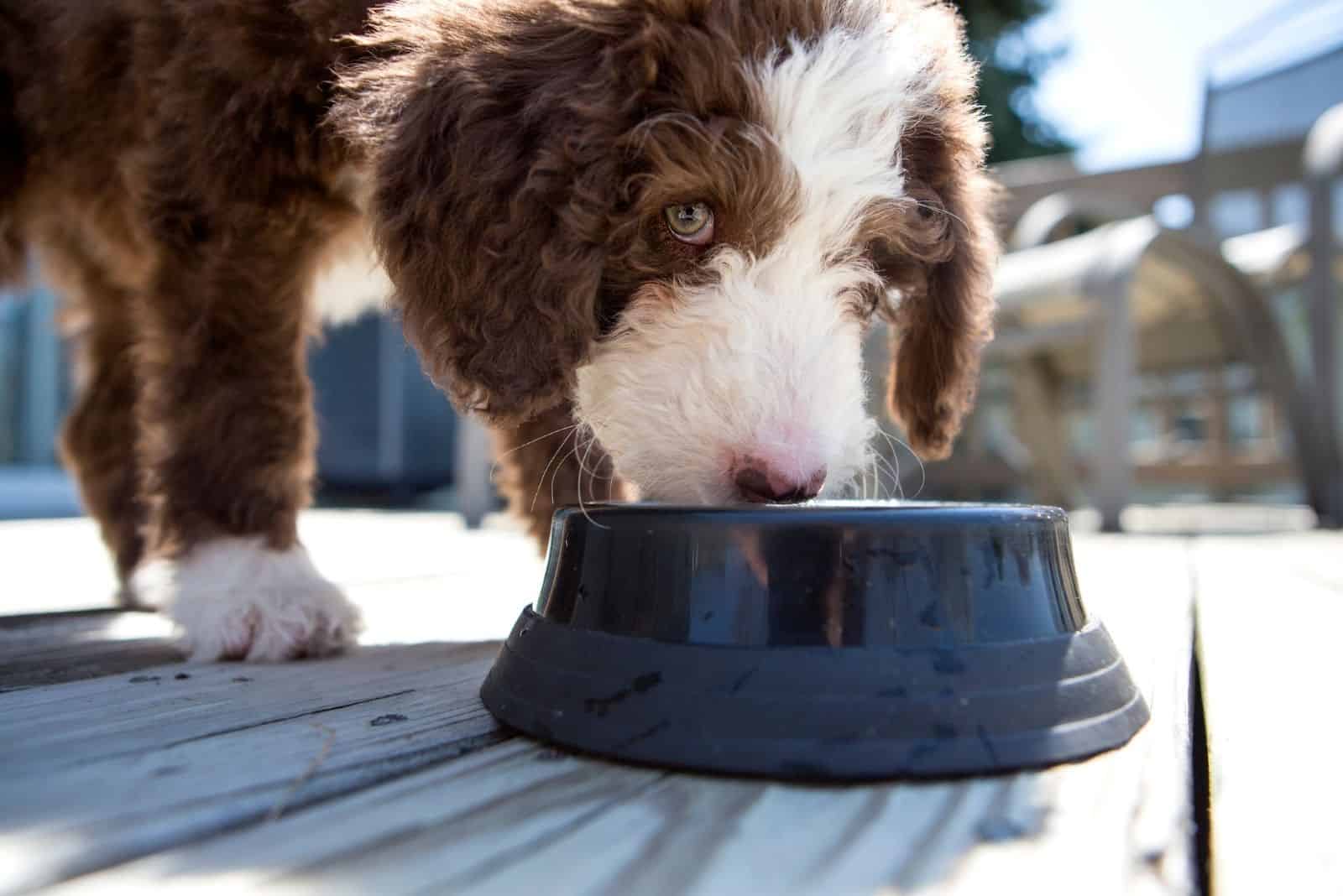
Believe it or not, the food your puppy is eating can definitely affect its overall health status and growth.
After all, food affects us, too. There’s really no point in questioning whether food affects puppies.
Once they’re born, puppies rely on their mom’s milk. Slowly, as they’re growing up, the puppies are weaned and a transition to solid food happens.
Choosing the right dog food for your growing puppy is a crucial matter.
You should pick food with enough nutrients, and real animal proteins in first place.
A puppy that’s growing up nicely shouldn’t have ribs pointing out. The ribs should only be felt by applying small pressure. The puppy’s waist is visible from above, while you can notice a small abdominal tuck.
Anything else other than these markings is either considered obesity or malnutrition. Such puppies grow up slower and won’t reach their full potential.
For example, if your German Shepherd Husky mix is an underweight puppy, he will never get to be a large dog. Instead, he’ll be a slim pooch somewhere in the mid-sized range, and that’s all because of malnutrition.
Tips And Tricks For Picking A New Puppy!
When picking a new puppy, it’s best if you know some tips and tricks so you can choose the right one.
I’d like to help you a bit by pointing out some things.
First, you definitely need a good breeder. Since we’re talking about a mixed-breed puppy, you must be really careful. Avoid breeders who are listing dogs as teacup or micro. Those are unreliable people who over-breed for profit.
Depending on the crossbreed you’re wanting, ask the breeder to see some health tests, ask to see the parents, and ask about their health status and the puppy’s current overall health.
If you’re really interested in the puppy’s future size, it would be best to conduct some DNA tests. They will tell you all about your puppy’s pedigree and hereditary health issues, and you’ll be able to determine its future size.
Another way to tell how big a mixed puppy will get is by performing the visual tests we discussed earlier, i.e., the paw test.
Also, if your breeder tracks records about the puppy’s weight, ask to see the growth charts. By using the weight calculator from above, you’ll be able to figure the weight and height range that the puppy falls in between.
I know puppy parentage is hard. It’d be especially hard if you’re adopting a stray puppy without its known history. If you’re at that point in your life, your dog’s future size shouldn’t be a priority. The priority should be rescuing a life in need and giving it a new home.
Conclusion
How do you tell how big a mixed puppy will get?
If you went through this article in depth, you can now answer this question with confidence.
There are methods, calculations, and visual assessments. However, you can never be 100% sure of the dog’s future weight or height.
But, personally, I’m absolutely fine with getting at least a range of weight or height.
When picking a mixed-breed puppy, you should pay more attention to the puppy’s health instead of its size.
I know and I understand that the dog’s size is beyond important sometimes because you have a small apartment or little kids. In that case, go with a mixed-breed dog whose parents you know.
As I mentioned before, you won’t get a giant puppy from two small breeds like the Chihuahua and the Bichon Frise.
It gets trickier when the breeds are contrasting. But, luckily, you have our weight calculators, our height formula, and some visual cues to use to check out everything.
I thank you for your attention and wish you good luck in finding the ideal mixed-breed puppy. Puppy love comes in them all, no matter the breed.

